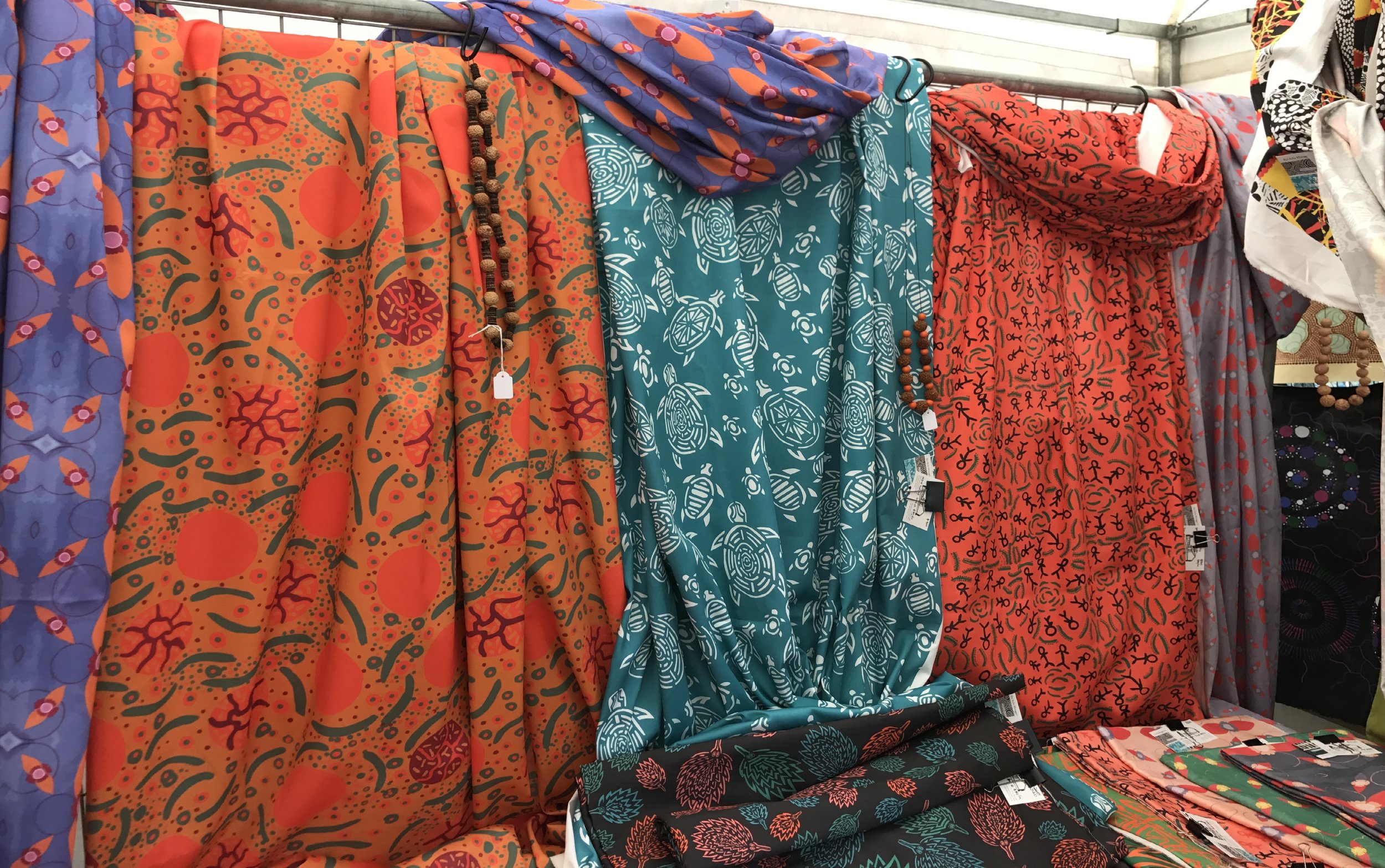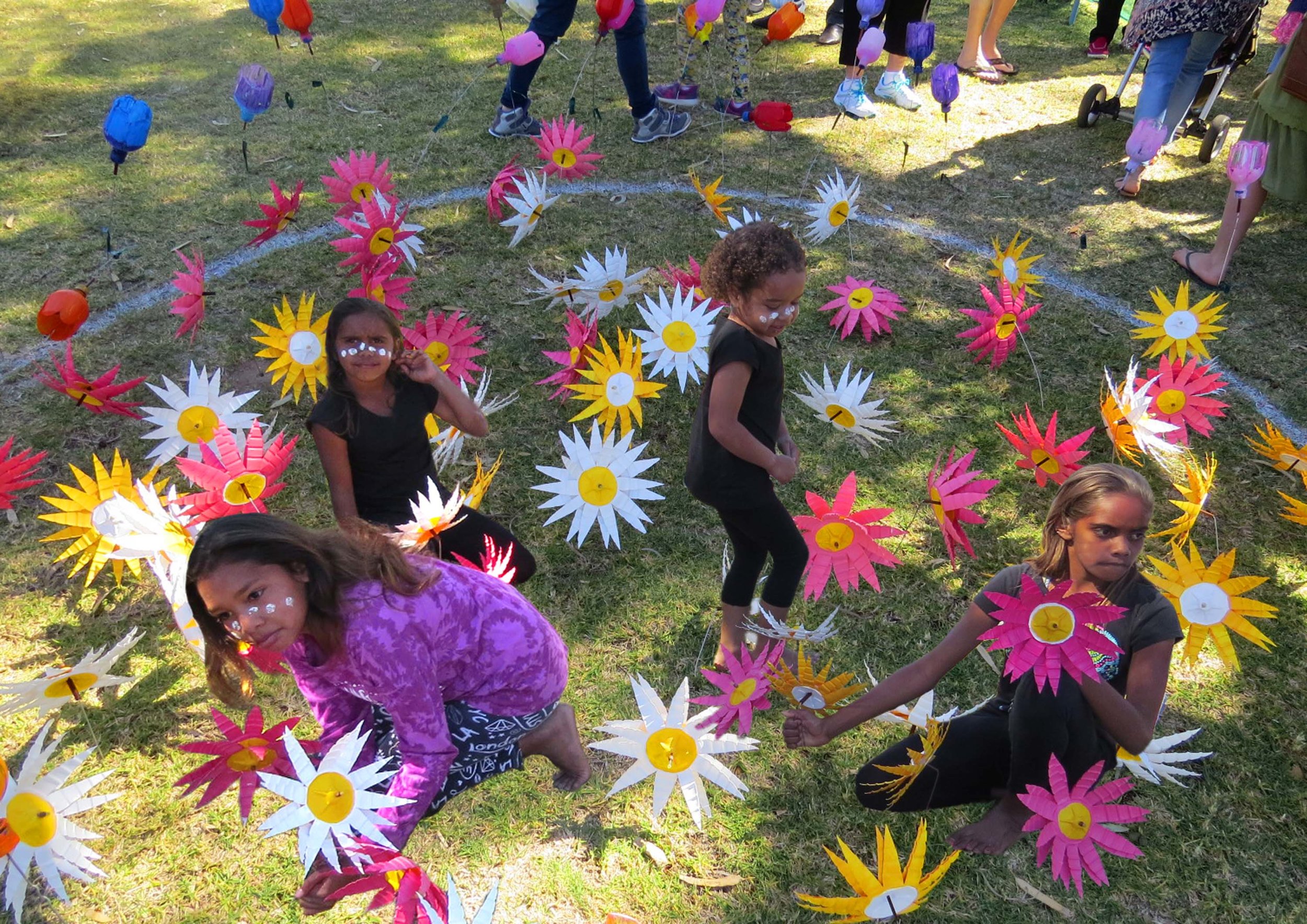What drew you to found the Ku'arlu Mangga (Good Nest) Nhanda community art group?
Our first pilot project for textiles was in 2016. We thought it was important that the artists had a voice in decision making and some legalities around commercial praise, including investment funds in the textiles and artists getting paid for sales that result from use of their designs. This is especially important as we evolve so that if someone leaves for seasonal (or other) employment, they still have a voice and still benefit from sales of their fabric designs. We also need to develop a strong brand to be successful so Ku’arlu Mangga was born as an artist reference group to the board. Now it has a label!
This is also supporting the Cultural leadership in our organization to drive more projects that are culturally based and for the benefit of the community and not just about implementing government policy through government funding. We are trying to become more social enterprise based so more local initiatives can get through and more economic opportunity can be created for local families.
Why was it important for all of you to offer a sustainable, responsible, Eco work/ How do you incorporate ideals such a Zero Waste into your process?
Sustainability has been with us from the beginning in some things, such as using found objects in our art practice and creating sculptures or art from recycled materials - simply because they were cheap projects to fund when we started our organization. A lot of regional people feel the absence of the kinds of recycling services that are available in the city and have anxieties about the environment.
This is also true of traditional custodians who don’t have a recognized role in land management or feel that there is inadequate protection of special places. We learned that our recycled materials art projects lift people’s spirits. Regarding the textiles specifically, zero waste is really important because our manufacturing cost is high, so any waste will be really expensive in downstream garment making and effect our competitiveness. Accessories such as our beads are organic and harvested sustainably.
As a newer initiative, Ku’arlu Mangga also has the opportunity to define the values of the team and how keep that close and implement it as we evolve. At present our main Eco strengths are local Indigenous design and all Australian manufacture of the textiles . We are looking at how to incorporate zero waste as we move into the garment side of things.
Our hope is to find effective, sympathetic partnerships, but we will tackle it ourselves if we need to. We are looking at organic fabrics and zero waste practices in new product development such as wraps and totes. It’s a work in progress on some fronts. We are working at understanding the whole manufacturing process, and making choices each time as we learn more.
Where do your artists find inspiration for new work?
There are a few different sources of inspiration in the group. For some of the artists, the Murchison River, from the sea at Kalbarri to far up river, is the main inspiration. It impacts their colour scheme and the structures they use around the designs such as the geometric patterns in Colleen’s work “triangles” and Mauretta’s “river”. The designs can express spirituality, such as Colleen’s leaf motifs in the current collection, or lifestyle memories of all the people on the river, such as Women’s Yarning Circles.
We have people in the community who grew up elsewhere and maintain really strong connection to more than one place, but water is a common theme, and where there is water, there is bush tucker. Mauretta’s Quandong fabrics are a strong example of this – the design is really confident and exuberant. Tahina does beautiful turtle compositions and Leanne expresses this in florals, especially memories of flowers such as Desert Pea in this collection. It can look really soft and feminine or really bold depending on the colour choices, working well for a variety of garments.
Youth is really important in this group of artists –we are all employed in some way in trying to achieve better outcomes for youth in our community. The artwork includes childhood memories and stories involving children. Our logo “Children dancing in the rain” is a good example. It is based on an original Message Sticks Carving by Colleen, which is from a childhood memory of dancing when the rains came. The design has been replicated as a lino print and will be available on fabric in our next production run.
All of the artists have bush tucker themes also, which is sometimes expressed figuratively, and sometimes in really strong abstracts. I think the diversity is one of the strengths in our group. We are never stuck for an idea for a collection!
Above all the inspiration comes from a celebration of Aboriginality. Nothing says this better than Mauretta’s River, and Tahina’s geometric pattern using patterns with the colours from the Aboriginal flag, and black and white dot compositions. The work is complex and uplifting.
What materials do you work with?
We produce cotton fabrics, quandong and eucalyptus beads, cotton, silk and organza wraps. Our designs are digitally rendered in a local collaboration, which is also a waste free process.
What are the biggest challenges you face?
Isolation and local manufacture impact on our production costs, but we think the result is worth it. Travel is also a big cost for us, so organizing to participate in events to promote ourselves is a pretty big undertaking. We have to be strategic.
Our biggest challenge at present is translating our beautiful designs and textiles into a sustainable business that really can make a difference to the artists and their families. We’re excited. We have established an on line shop, are adding product lines, and trying to get ourselves into the market place. Throughout the last decade, effective partnerships with other like minded people have been important to us, and we hope to forge some strong partnerships with our fabrics.
I think one of our challenges may be whether we have to move into garment production to sell our fabrics, which will be a more significant undertaking in terms of process.
We are also working with impoverished people and our experience is that recycling is easier to understand (such as the plastic bottles projects) than really investigating manufacturing processes to the origins of materials. We are making the same journey with food and understanding the full industrial processes around food. Even people on good incomes often remain impoverished due to the number of others they take in. So we have to be careful that we are delivering sustainability as something people care about and not making more rules to impose. The art projects such as the textiles operate in that space and give the artists strong ownership of the initiative and the outcomes.
How do you help customers understand the higher cost of sustainably made items when they are so inundated with sweat shop-produced cheap merchandise?
We’re still really new at this but so far the response has been really encouraging. The first thing is that being original Aboriginal designs means that purchases are really unique and benefit Aboriginal artists and their families. I think there are a lot of people who like to be supportive but don’t hang art on their walls. Wearing a unique garment is both original and engaged.
We also explain that everything is made here – the designs are from the local Aboriginal art team in Northampton. They have been digitally rendered in Geraldton and printed on 100% cotton in Eastern Australia. Usually people respond well to that.
Our first sales were made at an Aboriginal art market earlier this year and it was really interesting to see where the fabrics were going and who was buying –Australians traveling to Spain wanting something uniquely Australian to wear in Spain ,
Australians buying for Canadian daughter in law who always gifts Canadian products – Australians often struggle to find unique made in Australia gift ware that is in good taste.
Australian going to wedding into African family in Berlin – “the Africans will all be in their beautiful robes – I can’t go in a pastel off the shelf mother of the bride outfit”.
Perth men looking for distinctive shirts, especially men in creative and Indigenous organizations.
Local regional people wanting to support the venture, buying a metre of fabric to be part of our journey as a chapter in local events.
What can we look forward to seeing on the runway at Eco Fashion Week Australia 2018?
You will be seeing some beautiful young Aboriginal people modelling our textiles and accessories. We are looking at small collection of simple garments that display the beautiful artwork in the designs for our first foray.
Our intention was to limit to 8 simple garments, but we have quite a lot of young Aboriginal models who want to participate so we are looking at how we can show a bit more. At present we are showing day wear retro dresses, and mens shirts, with everyone accessorized from our own creations including carved wood objects, beads and collections of wraps, and totes.
How does your community incorporate sustainable living in other areas of daily life?
Our community organization is itself in a recycled building. By operating our community arts and youth centre we are saving the destruction of heritage buildings and reusing spaces that would have gone to waste and landfill if we had not stepped in 12 years ago. We use solar power.
We have a community garden which is giving us some scope to recycle waste a bit more. In the office some practices are entrenched and work really well. We have always run on recycled paper, and take our ink cartridges back to the supplier for recycling, for example. In other areas, especially food packaging it’s a work in progress. We recycle plastic bottles.
Anything else you would like readers to know?
Ku'arlu Mangga is the art centre team working out of Northampton Old School Community Initiative. Follow us on Facebook and check out our website!
Our logo design is one of the original Message Sticks carving designs "Children Dancing in the Rain" - a memory and art work of Colleen's. Ku'arlu Mangga is Nhanda for Good Nest, which is how we feel about our art room. We wanted to keep youth in our labeling because they are at the centre of all that we do. If you want to see the fabrics we are taking to the event, go to our online shop following the web link on this page!
Links -
- Website - www.nosci.com.au/
- Instagram - www.instagram.com/kuarlu/
- Facebook - www.facebook.com/NorthamptonOldSchool/





